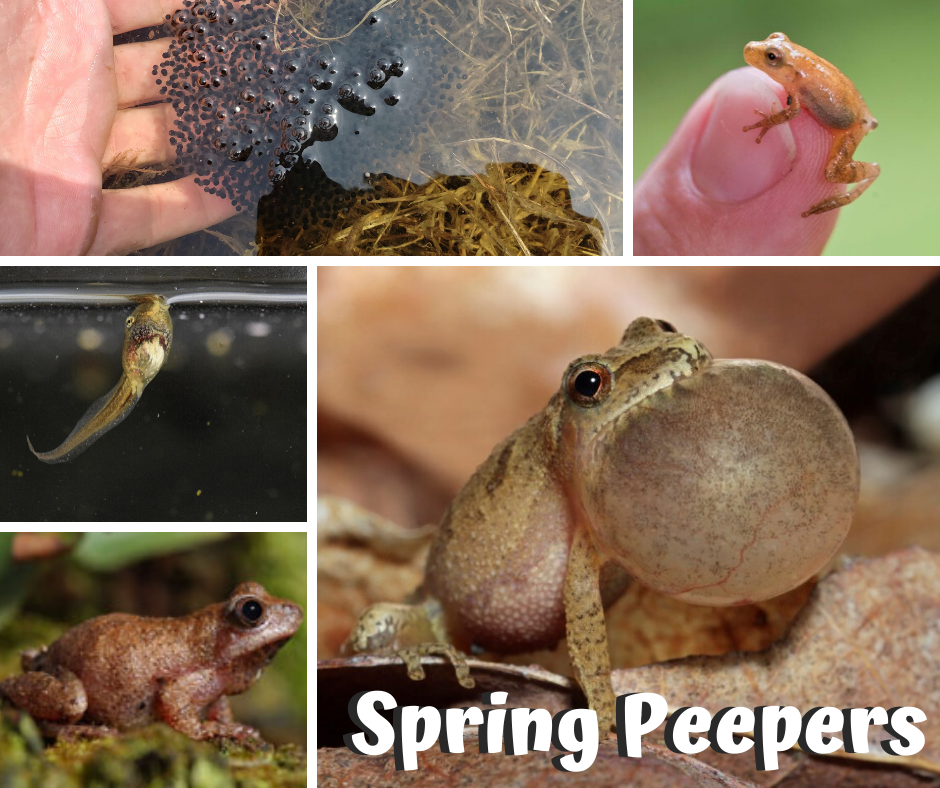Spring Peeper
By: Kristi Wion
Who is up next you may ask? Well, it’s our teeny, tiny amphibian tree frog friend who likes to chirp and sing all night long – the Spring Peeper (Pseudacris crucifer).

What do they look like?
- Their bodies have smooth skin in shades of tan, brown, green, or gray, with lines that form an X-shaped pattern on their backs.
- Their bellies are white to cream-colored, and they have dark bands on their legs and a dark line between their eyes.
- Spring peepers are well camouflaged to look like tree bark and have some ability to make themselves lighter or darker in order to better match their surroundings.
- The flat, terminal pad on each of the amphibian’s toes allow it to grip onto plants, while its webbed hind feet give it support.
- Although they are good climbers, they spend most of their time on the ground, often hiding under leaf litter during the day.
- Spring peepers are rarely seen, but during mating season in the spring, they are often heard.
- The Northern spring peeper is so small that it could sit comfortably on a dime! They are generally about one inch (2.5 centimeters) in length, or about the length of a paper clip, and their weight averages from 0.11 to 0.18 ounces (3 to 5 grams).
What's that I hear? Spring Peepers must be near!
Where do they live?
- Spring peepers can be found from southeastern Canada to the eastern United States (including Ohio), south to northern Florida and west to Minnesota and eastern Texas.
- They live in moist, wooded areas, fields, and grassy lowlands near ponds and wetlands.
- Spring peepers hibernate during the winter in soft mud near ponds, under logs, and in holes or loose bark in trees.
What do they eat?
- Spring Peepers generally eat beetles, ants, flies, and spiders. Tadpoles feed on algae and microorganisms.
Why do they “peep”?
- Spring peepers are known for the males’ mating call—a high-pitched whistling or peeping sound repeated about 20 times a minute. However, the faster and louder they sing, the greater the chances of attracting a mate.
- The Spring Peeper’s bubble is actually the frog’s vocal sac. To make their calls, peepers close their nostrils and mouths and squeeze their lungs, which causes the vocal sac in the throat to inflate like a balloon. The peeping sound happens as air leaves the lungs, passes over the vocal cords and into the vocal sac.
- They often congregate near water and sing in trios, with the deepest-voiced frog starting the call. They begin breeding early in the spring and call on warm spring nights and during the day in rainy or cloudy weather.
- As their name implies, their call is a sleigh-bell-like chorus that can be heard from a great distance.
What about baby Peepers?
- Females lay their eggs in vernal pools, ponds, and other wetlands where fish are not present. A female may lay anywhere from 750 to 1,200 eggs, which attach to submerged aquatic vegetation.
- Depending on the temperature, eggs can hatch within two days to two weeks.
- The tadpoles have gills to breathe underwater and tails to help them swim. Tadpoles transform into frogs over the course of 6 to 12 weeks.
Watch these baby peepers develop and hatch!
Fun Facts
- Spring peepers are very tolerant of cold conditions. They can withstand freezing during winter hibernation due to a natural “antifreeze” in their blood.
- Up to 70% of the frog’s body can freeze, to the point that the heart stops pumping and the frog appears to be dead. Scientists still aren’t sure how frozen frogs can wake up again, but once they thaw out and wake up, most frogs will go through a period of healing before they resume their normal lives.
To learn more interesting facts about this tiny but mighty animal, check out these sources:
https://www.nationalgeographic.com/animals/amphibians/s/spring-peeper/
Want to make a Spring Peeper paper puppet? Here is a template from nature friends at Mass Audobon - click the image for instructions!

